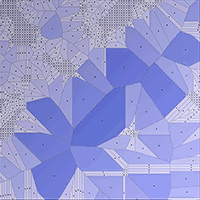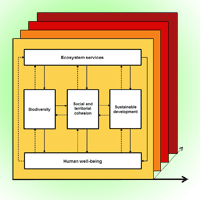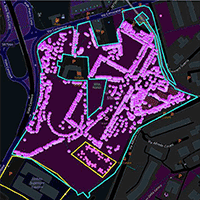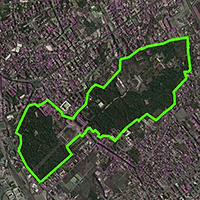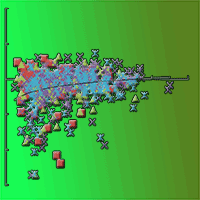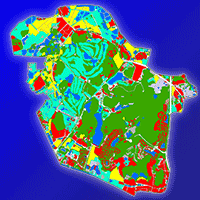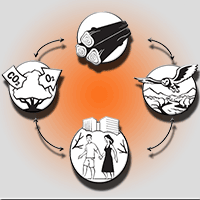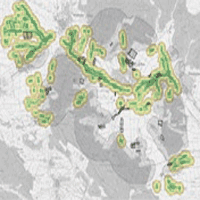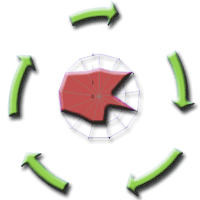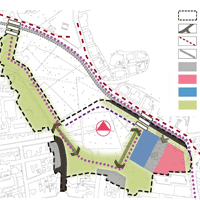
Green oriented urban development for urban ecosystem services provision in a medium sized city in southern Italy
Francesco Martinico, Daniele La Rosa , Riccardo Privitera
iForest - Biogeosciences and Forestry, Volume 7, Issue 6, Pages 385-395 (2014)
doi: https://doi.org/10.3832/ifor1171-007
Published: May 19, 2014 - Copyright © 2014 SISEF
Research Articles
Collection/Special Issue: RegioResources21
Spatial information and participation of socio-ecological systems: experiences, tools and lessons learned for land-use planning
Guest Editors: Daniele La Rosa, Carsten Lorz, Hannes Jochen König, Christine Fürst
Abstract
In southern Italy many cities are characterized by a lack of public urban greenspaces. Non-urbanized areas in these cities are suffering from surrounding urbanization pressures. These areas still provide important ecosystem services even if they are limited in size, highly fragmented and often neglected by local planning. New planning strategies are needed in order to protect and enhance the provision of ecosystem services delivered by existing Non-Urbanized areas, but municipalities usually have limited funds for acquiring public green areas via land expropriations. At the same time, requests for new urban development are still considerable. Consequently, it is not realistic to propose strategies for green areas that do not include new developments. The paper illustrates a strategy for a Green Oriented Urban Development (GOUD) that has been applied for the Master Plan of Catania, a medium sized city in Sicily (southern Italy). The strategy includes a limited amount of developments as well as new greenspaces in selected areas (Resource Zones), through the transfer of property and development rights between the municipality and developers. The strategy will allow to enhance the provision of ecosystem services, especially cultural services (thanks to a dramatic increase of accessibility to new greenspaces), regulating services (through climate regulation by new green land covers) and provisioning services such as urban agricultural products. Results show that it is possible to improve urban ecosystem services creating a more liveable and healthy urban environment at reduced cost for the municipal administrations.
Keywords
Authors’ Info
Authors’ address
Daniele La Rosa
Riccardo Privitera
Department of Architecture, University of Catania, v. S. Sofia, I-95125 Catania (Italy)
Corresponding author
Paper Info
Citation
Martinico F, La Rosa D, Privitera R (2014). Green oriented urban development for urban ecosystem services provision in a medium sized city in southern Italy. iForest 7: 385-395. - doi: 10.3832/ifor1171-007
Academic Editor
Raffaele Lafortezza
Paper history
Received: Oct 31, 2013
Accepted: Dec 27, 2013
First online: May 19, 2014
Publication Date: Dec 01, 2014
Publication Time: 4.77 months
Copyright Information
© SISEF - The Italian Society of Silviculture and Forest Ecology 2014
Open Access
This article is distributed under the terms of the Creative Commons Attribution-Non Commercial 4.0 International (https://creativecommons.org/licenses/by-nc/4.0/), which permits unrestricted use, distribution, and reproduction in any medium, provided you give appropriate credit to the original author(s) and the source, provide a link to the Creative Commons license, and indicate if changes were made.
Web Metrics
Breakdown by View Type
Article Usage
Total Article Views: 61089
(from publication date up to now)
Breakdown by View Type
HTML Page Views: 50090
Abstract Page Views: 4161
PDF Downloads: 5156
Citation/Reference Downloads: 58
XML Downloads: 1624
Web Metrics
Days since publication: 4229
Overall contacts: 61089
Avg. contacts per week: 101.12
Citation Metrics
Article Citations
Article citations are based on data periodically collected from the Clarivate Web of Science web site
(last update: Mar 2025)
Total number of cites (since 2014): 26
Average cites per year: 2.17
Publication Metrics
by Dimensions ©
Articles citing this article
List of the papers citing this article based on CrossRef Cited-by.
References
Agriculture in greenways: a methodology for planning connected urban and peri-urban farmlands in a Mediterranean city. In: Proceedings of “Fábos Conference on Landscape and Greenway Planning 2013: Pathways to Sustainability” (Fábos JG, Lindhult M, Ryan RL, Jacknin M eds). Amherst (MS, USA), 12-13 April 2013. Department of Landscape Architecture and Regional Planning, University of Massachusetts, Amherst, MS, USA, pp. 309-318.
Gscholar
Green infrastructure: linking landscapes and communities. Island Press Washington, DC, USA, pp. 299.
Gscholar
The limitless city: a primer on the urban sprawl debate. Island Press, Washington, DC, USA, pp. 328.
Gscholar
Managing community growth: policies, techniques, and impacts. Praeger, Westport, CT, USA, pp. 264.
Gscholar
Non urbanised areas in metropolitan context: between ecosystem services and urban sprawl. CreateSpace, Charleston, SC, USA, pp. 138.
Gscholar
A European assessment of the provision of ecosystem services: towards an atlas of ecosystem services. EUR 24750 EN - 2011, EC/JRC, Ispra, Italy, pp. 88.
Gscholar
How well can markets for development rights work? Evaluating a farmland preservation program. Discussion Paper 03-08, Resources for the Future, Washington, DC, USA, pp. 54.
Gscholar
Ecosystems and human wellbeing: biodiversity synthesis. World Resources Institute, Washington, DC, USA, pp. 100.
Gscholar
Managing growth in America’s communities. Island Press, Washington, DC, USA, pp. 336.
Gscholar
Niches in the urban forest: organizations and their role in acquiring metropolitan open space. Journal of Forestry 100: 16-23.
Gscholar
L’economia del Piano [The economy of the plan]. Annex to Catania Master Plan, Internal document, Catania, Italy, pp. 88.
Gscholar

